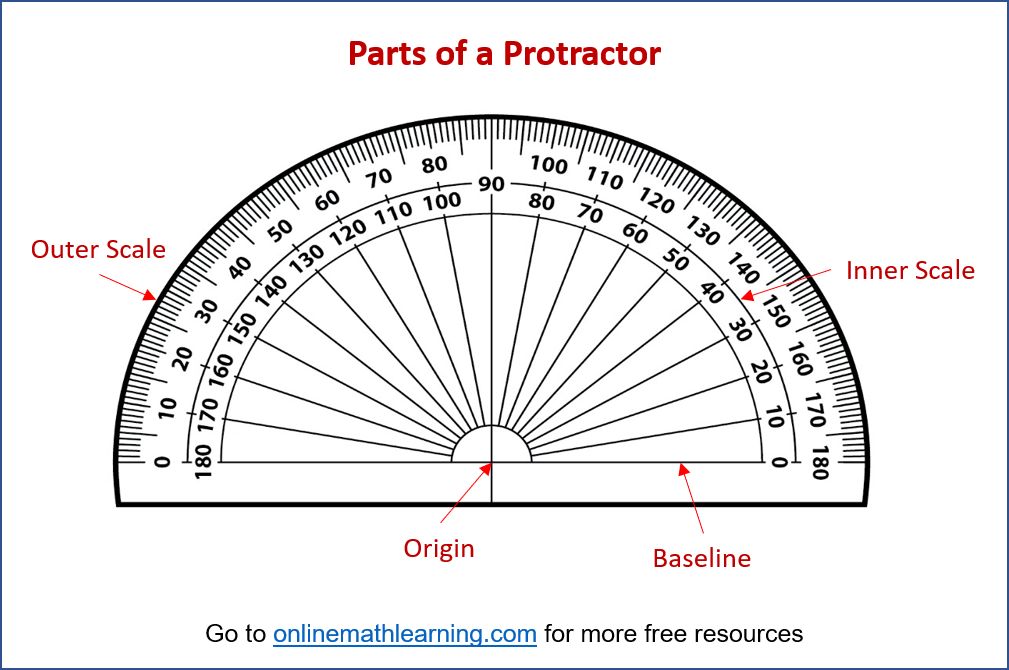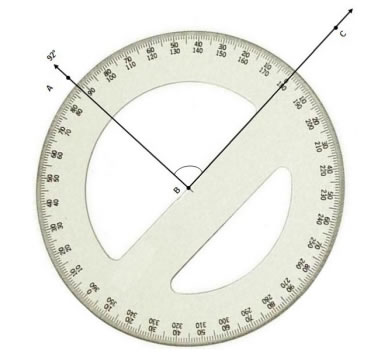Measure Angles using a Protractor
Related Topics:
More Lessons for Grade 6
Angle Games
Videos, examples, solutions, stories and songs to help Grade 4 to Grade 6 students learn how to measure angles in degrees using a protractor.
How to Measure Angles?
Measuring angles is a common task in geometry, and the primary tool used for this is a protractor. A protractor is typically a semicircular tool marked with degrees from 0° to 180°. It has a straight baseline and a central point on that baseline.
Parts of a Protractor
The following diagrams show the parts of a protractor. Scroll down the page for more examples and solutions.

Geometry Worksheets
Practice your skills with the following worksheets:
Printable & Online Geometry Worksheets
1. Baseline (or Straight Edge): The flat, straight bottom edge of the protractor.
2. Origin (or Center Hole/Point): A cross mark exactly at the center of the baseline. This is where the vertex of your angle will go.
3. Inner Scale: A set of numbers from 0˚ to 180˚ that increases right to left.
4. Outer Scale: A set of numbers from 0˚ to 180˚ that increases left to right.
Step-by-Step Guide to Measuring an Angle:
Let’s assume you have an angle drawn on a piece of paper, and you want to find its measure in degrees.
1. Identify the Angle’s Parts
Locate the vertex of the angle (the point where the two lines, or rays, meet).
Identify the two rays (the lines that form the sides of the angle).
2. Extend Rays (if necessary)
Sometimes, the rays of the angle might be too short to reach the numbered scale on your protractor. If this is the case, use your ruler and pencil to carefully extend one or both rays so they are long enough to pass beyond the protractor’s scale. Make sure your extensions are perfectly straight and follow the original line.
3. Place the Protractor Correctly
a) Align the Origin: Place the origin of your protractor exactly on the vertex of the angle.
b) Align the Baseline: Carefully align the baseline of the protractor perfectly along one of the angle’s rays.
(Most protractors have two sets of numbers, one going from 0° to 180° in one direction, and another going from 0° to 180° in the opposite direction. Choose the scale where the ‘0’ aligns with your chosen base ray.)
4. Read the Angle Measurement:
a) Identify the Correct Scale: Start reading from the ‘0’ mark on the scale that is aligned with your chosen base ray.
b) Follow the Scale: Without moving the protractor, follow that same scale around the curved edge until you reach the point where the other ray of your angle intersects the scale.
c) Read the Number: The number where the second ray crosses the scale is the measure of your angle.
Practice measuring angles with the following interactive activity:
How to construct your own protractor
A degree is the unit used to measure rotation within a circle and can be used to measure angles. The measure of rotation for a full turn within a circle will always be 360°. This is true regardless of the size (diameter) of the circle.
You can construct your own 360° protractor using a circular piece of paper.
• A circle (full turn) has a measure of 360°.
• Fold the circle in half. If a full circle measures 360°, a half of a circle must
measure 180°.
• Fold the half circle in half again. This represents a quarter of the whole circle. If half
of the circle measures 180°, a quarter must measure 90°.
• Fold the quarter circle in half again. This represents an eighth of the whole circle. If a
quarter of the circle measures 90°, an eighth must measure 45°.
• Unfold the circle. There should be eight sets of 45° in the whole.
• Choose a fold line as 0°; label each fold line in the counterclockwise direction as a consecutive multiple of 45°, as shown below.

When measuring angles using a protractor it is important that the reading always begins at zero. Do not make the mistake of beginning at the 180° mark. You must always line up one arm of the angle with the zero degree and then begin counting up from zero until they reach the next arm. This will avoid incorrect scale readings. The degrees on the protractor are only labeled in multiples of ten, however each unlabeled tick represents 1°. The center point of the protractor must be placed on the vertex of the angle and the zero degree mark of the protractors baseline must be lined up with one of the angle’s arms.
Some protractors have an inner scale and an outer scale. It is important to recognize that the direction of rotation between angle arms to determine which scale is used on the protractor. Always line up the zero degree with the first arm of the angle and count up to the next arm to avoid any confusion with regard to which scale should be used. The arc (hatch mark) between the arms of the angle indicates which angle is being measured.
The following diagram shows how to measure the angle ∠ABC using a protractor.

Videos
How to measure angles using a protractor?
Use a full circle or half circle protractor to learn to measure angles.
How to use a protractor?
Measuring Angles with a Protractor
How to measure an angle with a protractor?
How to use a protractor to measure and draw angles?
How to Use a Protractor to Measure Angles?
Try out our new and fun Fraction Concoction Game.
Add and subtract fractions to make exciting fraction concoctions following a recipe. There are four levels of difficulty: Easy, medium, hard and insane. Practice the basics of fraction addition and subtraction or challenge yourself with the insane level.

We welcome your feedback, comments and questions about this site or page. Please submit your feedback or enquiries via our Feedback page.